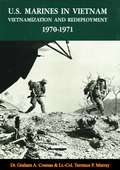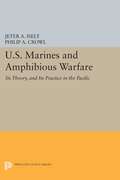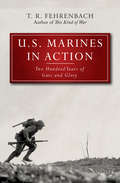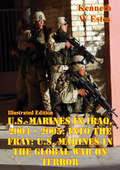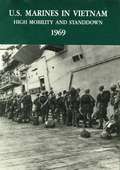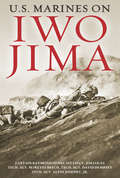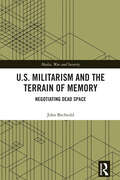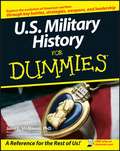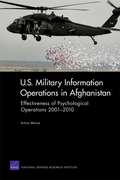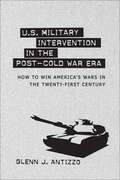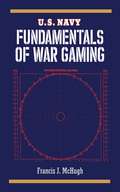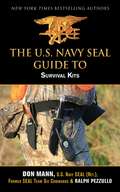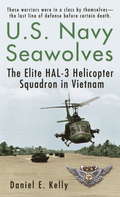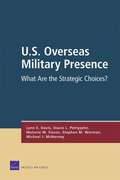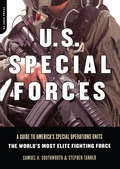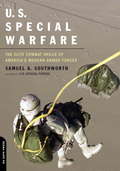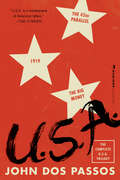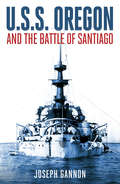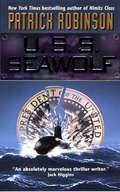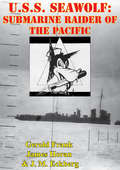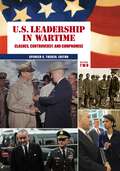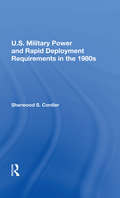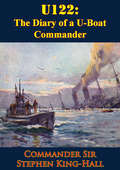- Table View
- List View
U.S. Marines In Vietnam: Vietnamization And Redeployment 1970-1971 (U.S. Marines In Vietnam)
by Lt.-Col. Terrence P. Murray Dr Graham A. CosmasThis publication represents the eighth volume in an operational and chronological series covering the Marine Corps' participation in the Vietnam War. This particular volume details the gradual withdrawal in 1970-1971 of Marine combat forces from South Vietnam's northernmost corps area, I Corps, as part of an overall American strategy of turning the ground war against the North Vietnamese and Viet Cong over to the Armed Forces of the Republic of Vietnam.Although written from the perspective of III MAF and the ground war in I Corps, the volume treats the activities of Marine advisors to the South Vietnamese Armed Forces, the Seventh Fleet Special Landing Force, and Marines on the staff of the U.S. Military Assistance Command, Vietnam, in Saigon. There are separate chapters on Marine air, artillery, and logistics. An attempt has been made to place the Marine role in relation to the overall effort.
U.S. Marines and Amphibious Warfare (Princeton Legacy Library #2407)
by Philip A. Crowl Jeter A. Isely"Not only a just appraisal of the campaigns waged by Marines in World War II; it is a documentation of the Marine struggle to prove the feasibility of amphibious warfare.... Relentlessly accurate and impartial." —N.Y. Times.Originally published in 1951.The Princeton Legacy Library uses the latest print-on-demand technology to again make available previously out-of-print books from the distinguished backlist of Princeton University Press. These editions preserve the original texts of these important books while presenting them in durable paperback and hardcover editions. The goal of the Princeton Legacy Library is to vastly increase access to the rich scholarly heritage found in the thousands of books published by Princeton University Press since its founding in 1905.
U.S. Marines in Action: Two Hundred Years of Guts and Glory
by T. R. FehrenbachTen major wars and two hundred minor actions comprise the history of the United States Marine Corps, and parallel the history of America itself. U.S. Marines in Action provides a comprehensive and stirring account of the activities of the military corps that has become synonymous with guts and glory. Fehrenbach dramatizes the incredible heroism of the leathernecks over two centuries of peacekeeping missions in every corner of the globe.
U.S. Marines in Iraq, 2004 - 2005: U.S. Marines in the Global War on Terror [Illustrated Edition]
by Kenneth W EstesIncludes 103 photos, maps and illustrationsThe following account represents one of the earliest efforts to chronicle Marine Corps operations in Iraq between 2004 and 2005. This was a significant period in the history of Operation Iraqi Freedom, seeing two battles fought over the city of Fallujah, the eruption of the Sadr revolt in an-Najaf, continuous counterinsurgency operations throughout Iraq, and initial efforts on the part of Marines to cultivate and forge alliances with the tribes of Iraq's al-Anbar Province.Almost as soon as Saddam Hussein's regime collapsed in 2003, it became apparent to U.S. commanders that a second deployment of Marines to Iraq would be necessary to conduct security and stability operations. This monograph recounts the first two years of this second deployment during which Marines were responsible for Iraq's vast al-Anbar Province. This study focuses on I Marine Expeditionary Force's deployment in 2004 and II Marine Expeditionary Force's deployment of 2005, paying close attention to planning, counterinsurgency operations, and efforts to build civil-military relations with the Iraqi population. Particular attention is also paid to the first and second battles of Fallujah and the battle of an-Najaf.
U.S. Marines in Vietnam: High Mobility and Standdown 1969 (Marine Corps Vietnam Series)
by Charles R. Smith U.S. Marine Corps History and Museums DivisionThis volume details the change in United States policy for the Vietnam War. After a thorough review, President Richard M. Nixon adopted a policy of seeking to end United States military involvement in Vietnam either through negotiations or, failing that, turning the combat role over to the South Vietnamese. It was this decision that began the Vietnamization of the war in the summer of 1969 and which would soon greatly reduce and then end the Marine Corps’ combat role in the war.The Marines of III Marine Amphibious Force continued the full range of military and pacification activities within I Corps Tactical Zone during this period of transition. Until withdrawn, the 3rd Marine Division, employing highly mobile tactics, successfully blunted North Vietnamese Army efforts to reintroduce troops and supplies into Quang Tri Province. The 1st Marine Division, concentrated in Quang Nam Province, continued both mobile offensive and pacification operations to protect the city of Da Nang and surrounding population centers. The 1st Marine Aircraft Wing provided air support to both divisions, as well as other allied units in I Corps, while Force Logistic Command served all major Marine commands.Although written from the perspective of III MAF and the Marine ground war in I Corps, an attempt has been made to place the Marine role in relation to the overall American effort. The volume also treats the Marine Corps’ participation in the advisory effort, the operations of the Seventh Fleet Special Landing Force, and, to a lesser extent, the activities of the 101st Airborne Division (Airmobile), 23rd Infantry (Americal) Division, and 1st Brigade, 5th Infantry Division (Mechanized). There are separate chapters on Marine air, artillery, surveillance, and logistics.
U.S. Marines on Iwo Jima
by Captain Raymond Henri 1st Lieut. Jim G. LucasThe US Marines on Iwo Jima, first published in 1945, and written by five on-the-scene combat correspondents, is a highly readable account of the invasion by U.S. Marines of this tiny yet strategically important volcanic island. The book is based on each author's own observations while on the island, plus the experiences of dozens of men involved in various aspects of the intense fighting. Presented in chronological order, the battle unfolds from the initial D-Day air force bombings and naval barrage, to the amphibious assault, to the slow gains made each day as the Marines inched forward under heavy fire. Despite its small size, Iwo Jima was considered the most heavily fortified island in the world, supporting thousands of nearly bomb-proof shelters and caves, hundreds of reinforced machine-gun, mortar, tank, and artillery positions, and more than 20,000 fanatical Japanese defenders. Included is a roster of Marines killed or missing in the battle, plus 12 maps and 32 pages of photographs.
U.S. Militarism and the Terrain of Memory: Negotiating Dead Space (Media, War and Security)
by John BechtoldThis book analyzes how the Iraqi city of Fallujah became registered as a setting for military heroics in American memory.In 2004, the U.S. military conducted two disastrous assaults in Fallujah, Iraq. More than 1,000 citizens were killed, and, according to the military’s own estimate, upwards of 200,000 people were displaced because of the violence. Yet, despite this human catastrophe, the kind of information that emerged in the public domain during the battle foregrounded the soldier's experience in war while effacing the destruction of Iraqi bodies. This tendency to foreground the soldier body is a direct result of the military’s intervention in what they conceptualize as the "information environment." This book draws from the second assault in Fallujah as a case study to explicate the military’s investment in this perspectival space, which is a consequence both of the mediatization of contemporary war and of the need to influence knowledge considered unfavorable to military operations. In short, the military enlists the media in their targeting process to produce information that is then deployed as persuasive force to modify the beliefs of specific target populations. When the cultural texts produced by the media are remediated in the public domain after war, they can be thought of as martial constructs because they originated during war through the military’s systemized attempt to influence knowledge. That is, these texts trace to a specific battlefield objective. This book reframes the notion of propaganda as a generalized public relations strategy into a more acute and coordinated attempt to decontextualize specific knowledge in the information environment.This book will be of much interest to students of media and communication studies, war studies, memory studies, and international relations.
U.S. Military History For Dummies
by John C. McmanusWant to know more about American military history? U.S. Military History For Dummies presents concise and revealing accounts of all of the nation's armed conflicts from the French and Indian War to Iraq. It explains how the U.S. military is organized and how its branches operate, both independently and together.This straightforward guide examines the causes for each of America's wars and reveals how these conflicts have shaped the nation's borders, society, politics, culture, and future. You'll meet heroes, cowards, patriots, and traitors; relive great battles; and get a taste of what combat is really like, as you discover:How the French/Indian war sowed the seeds of the Revolutionary WarWhy America's battle for independence didn't end at YorktownEarly U.S. wars against Indians, tax cheats, and piratesThe War of 1812: guaranteeing U.S. sovereignty"Manifest Destiny" wars that stretched America from sea to shining seaWhy the American Civil War could not be avoidedThe Spanish American War and the U.S. as an emerging global powerWhy World War I failed to "make the world safe for democracy"How World War II changed America's role in the worldKorea and Vietnam: hot wars during the Cold WarFeaturing important insights on technological, political, and social changes that transformed the way America fights its wars U.S. Military History For Dummies is your key to understanding the evolution of the most powerful military force in history.
U.S. Military Information Operations in Afghanistan: Effectiveness of Psychological Operations 2001-2010
by Arturo MunozThe U. S. Marine Corps, which has long recognized the importance of influencing the civilian population in a counterinsurgency environment, requested an evaluation of the effectiveness of thepsychological operations element of U. S. military information operations in Afghanistan from 2001 to 2010 based on how well messages and themes were tailored to target audiences. This monograph responds to that request.
U.S. Military Intervention in the Post-Cold War Era: How to Win America's Wars in the Twenty-first Century (Political Traditions in Foreign Policy Series)
by Glenn J. AntizzoDuring the post--World War II era, American foreign policy prominently featured direct U.S. military intervention in the Third World. Yet the cold war placed restraints on where and how Washington could intervene until the collapse of the former Soviet Union removed many of the barriers to -- and ideological justifications for -- American intervention. Since the end of the cold war, the United States has completed several military interventions that may be guided by motives very different from those invoked before the collapse of the Berlin Wall. Likewise, such operations, now free from the threat of counterintervention by any other superpower, seem governed by a new set of rules.In this readily accessible study, political scientist Glenn J. Antizzo identifies fifteen factors critical to the success of contemporary U.S. military intervention and evaluates the likely efficacy of direct U.S. military involvement today -- when it will work, when it will not, and how to undertake such action in a manner that will bring rapid victory at an acceptable political cost. He lays out the preconditions that portend success, among them a clear and attainable goal; a mission that is neither for "peacekeeping" nor for "humanitarian aid within a war zone"; a strong probability the American public will support or at least be indifferent to the effort; a willingness to utilize ground forces if necessary; an operation limited in geographic scope; and a theater commander permitted discretion in the course of the operation. Antizzo then tests his abstract criteria by using real-world case studies of the most recent fully completed U.S. military interventions -- in Panama in 1989, Iraq in 1991, Somalia in 1992--94, and Kosovo in 1999 -- with Panama, Iraq, and Kosovo representing generally successful interventions and Somalia an unsuccessful one. Finally, he considers how the development of a "Somalia Syndrome" affected U.S. foreign policy and how the politics and practice of military intervention have continued to evolve since the terrorist attacks of September 11, 2001, giving specific attention to the current war in Afghanistan and the larger War on Terror. U.S. Military Intervention in the Post--Cold War Era exemplifies political science at its best: the positing of a hypothetical model followed by a close examination of relevant cases in an effort to provide meaningful insights for future American international policy.
U.S. Naval Forces' Capabilities for Responding to Small Vessel Threats: Abbreviated Version of a Classified Report
by Physical Sciences Committee on U.S. Naval Forces' Capabilities for Responding to Small Vessel Threats Naval Studies Board Division on EngineeringAt the request of the former Chief of Naval Operations, the National Research Council appointed an expert committee to examine U.S. Naval Forces' capabilities for responding to the potential exploitation of small vessels by adversaries. The Department of the Navy determined that the report prepared by the committee is classified in its entirety under Executive Order 13526 and therefore cannot be made available to the public. This abbreviated report provides background information on the full report and the committee that prepared it.
U.S. Navy Fundamentals of War Gaming (US Army Survival)
by Francis J. MchughThe classic text, U.S. Navy Fundamentals of War Gaming, provides an in-depth introduction to the basics of military gaming and offers historical insights into the development of war gaming methodologies. It covers the evolution of gaming tools such as ancient adaptations of chess and the development of Kriegspiel to teach military tactics to Prussian officers. The employment of gaming by various military powers, before and during the World Wars, is explored and culminates with the introduction of computer support and simulations in the U.S. Navy.Also presented is a comprehensive treatment of the various forms of war gaming, from manual games to computer-assisted games; from one-sided to multi-sided games; and from free-play games to rigid-style games. McHugh addresses every aspect of gaming imaginable, including data requirements, design, execution, and analysis. Even the use of probabilistic tables to emulate stochastic processing and the use of flow diagrams for decisions are included.McHugh was a member of the Naval War College staff when that institution became the forerunner of all U.S. military services for applying gaming technology to educate officers and to evaluate tactical situations, operations, and strategy. He traces the history of gaming at the College from Lt.William McCarty Little in the late 1800s to the employment of the NEWS (Naval Electronic Warfare Simulator) in the twentieth century.
U.S. Navy SEAL Guide to Survival Kits
by Don MannIt’s important to be prepared for any contingency, and you can do that by carrying a survival kit in your pack. Here, survival expert Don Mann explains the differences between survival kits for warm weather, cold climate, and overwater. Basic items for each are listed, as are the basic items that SEALs always take with them. Tips on how to prepare your kit and become familiar with its contents are covered. Mann also touches on basic food, water, shelter, fire-starting materials, first aid, and much more.Skyhorse Publishing is proud to publish a range of books for readers interested in military tactics and skills. We publish content provided by or of interest to the U.S. Army, Army Rangers, the U.S. Navy, Navy SEALs, the U.S. Air Force, the U.S. Marine Corps, and the Department of Defense. Our books cover topics such as survival, emergency medicine, weapons, guns, weapons systems, hand-to-hand combat, and more. While not every title we publish becomes a New York Times bestseller or a national bestseller, we are committed to publishing books on subjects that are sometimes overlooked by other publishers and to authors whose work might not otherwise find a home.
U.S. Navy Seawolves
by Daniel E. KellyThere were no dry runs for Seawolves in Vietnam. They put their lives on the line--every time. In the Viet Cong-infested Mekong Delta, where small SEAL teams were always outgunned and outnumbered, discovery brought swift, deadly consequences-- and a radio call for backup from the United States Navy's very best: the Seawolves. The whir of approaching rotor blades signaled their arrival as they tore through the jungle at treetop level, gunners hanging off the skids, shooting M-60s, raining down their lethal mix of high explosives and incendiary death. Seawolf Dan Kelly describes the origins of this extraordinary outfit. Put through a training program unlike any other, these men emerged to perform unparalleled feats of courage. The stories of these elite warriors capture America's real heroes in all their guts and glory, and demonstrate why the Seawolves are known as the most successful and most decorated unit in the Vietnam War.
U.S. Overseas Military Presence: What Are the Strategic Choices?
by Lynn E. Davis Stacie L. Pettyjohn Melanie W. Sisson Stephen M. Worman Michael J. McnerneyThe role of the United States and its global military presence are under debate in the face of changing strategic and economic realities. The authors present a menu of global postures and compare them in terms of the U. S. Air Force bases, combat forces, active-duty personnel, and base operating costs. Ultimately, the choice will depend on perspectives on the role overseas military presence can play in achieving U. S. global security interests.
U.S. Special Forces: A Guide To America's Special Operations Units -- The World's Most Elite Fighting Force
by Stephen Tanner Samuel A. SouthworthPresident George W. Bush has told all Americans that the war against terrorism would be like no other war. But what does this mean? Who will fight? How will they fight? What weapons will be used? Most informed commentators agree that the war against terrorism will be fought largely by "special forces"-that is, by a relatively new community within the American military known as Special Operations Forces, or SOF's. This new "branch" of the armed forces was created in the mid-1980s and is organized under its own unified command, called U. S. Special Operations Command (SOCOM). Consisting of special units from the other branches of the armed forces, such as Green Berets, Rangers, SEALs, and Delta Force, this new fighting command is recognized internationally as the most well-trained and well-equipped special operations force in the world. Their missions are varied-including combat terrorism, search and rescue, reconnaissance, humanitarian assistance, peacekeeping duty, and conventional and unconventional warfare. Despite special forces’ international reputation for excellence, Americans know little about this remarkable fighting force. U. S. Special Forces provides a handy and comprehensive compendium, including descriptions of the units and their operational specialties, training, and organization, as well as the equipment and technological gadgetry, weapons, armor, planes, helicopters, and support vehicles used by each unit.
U.S. Special Operations Forces in the Philippines, 2001–2014
by Linda Robinson Gillian S. Oak Patrick B. JohnstonThis report examines the 14-year experience of U.S. special operations forces in the Philippines from 2001 through 2014 and the activities and effects of special operations capabilities employed to address terrorist threats in Operation Enduring Freedom--Philippines through training and equipping Philippine security forces, providing operational advice and assistance, and conducting civil-military and information operations.
U.S. Special Warfare: The Elite Combat Skills of America's Modern Armed Forces
by Samuel A. SouthworthFor many centuries, the job of everyday soldiers, the "grunts," was the same-"see the hill, take the hill. " But the combat role of today's U. S. soldier has undergone a radical change. <P><P>The recent revolution in the art of soldiering in America emphasizes a smaller, but more highly specialized and technologically equipped, armed force. Now, even everyday soldiers in America's armed forces specialize in elite combat skills that use the very latest high-tech equipment. After basic training, many of today's recruits continue advanced training in one of the new emerging combat specialties, such as urban, mountain and arctic warfare; amphibious, underwater and small boat operations; modern cavalry combat; sniping; military intelligence and psychological warfare; search and rescue procedures, and combat engineering. In lively and entertaining prose, military historian Sam Southworth describes these emerging combat specialties-as well as the training and equipment for each-that characterize America's fighting force today.
U.S.A.: The Complete Trilogy [The 42nd Parallel, 1919, and The Big Money] (U.S.A. Trilogy #3)
by John Dos PassosU.S.A. has descriptive copy which is not yet available from the Publisher.
U.S.S. Oregon and the Battle of Santiago
by Joseph C. GannonThe U.S.S. Oregon and the Battle of Santiago, first published in 1958, is an eyewitness account of the famous Spanish-American War sea battle off the coast of Cuba in 1898. Written by crewmember Joseph Gannon, the book describes the Oregon's long voyage of nearly 16,000 miles from Bremerton, Washington, to Peru, around Cape Horn at the southern tip of South America (the Panama Canal was not yet built), Rio de Janeiro (where the ship learned that war with Spain had been declared), and finally on to the Caribbean (where Gannon joined the ship's crew) as part of the blockade fleet on Cuba. On July 3, 1898, the Oregon and the cruiser Brooklyn were the only two ships fast enough to chase down the Spanish cruiser Cristóbal Colón, forcing its surrender. The Oregon's successful long voyage and performance in the war earned her the nickname of “the Bulldog.” Also, the length of the voyage around the Americas, requiring more than two months, bolstered public support for the construction of the Panama Canal. The Oregon would go on to serve in the Philippines, China, World War I, and her stripped hull was used in World War II at Guam as an ammunition barge. Included are a ship's roster and 7 pages of illustrations.
U.S.S. Seawolf (Arnold Morgan #4)
by Patrick RobinsonArmed with stolen U.S. military technology, the Chinese are producing a frightening new breed of weaponry,led by the ICBM submarine Xia III -- a vessel that just might be able to launch a nuclear warhead across the Pacific Ocean and take out an American West Coast city. National Security Adviser Admiral Arnold Morgan can't let that happen, and he dispatches the most stealthy hunter-killer submarine in the U.S. fleet, the 9,000-ton ultrasecret Seawolf, deep into the dark, forbidden waters of the South China Sea. But then the unthinkable happens: Seawolf, collides with a Chinese destroyer and falls into enemy hands. A team of cunning Navy SEALs -- the biggest Special Forces assault group assembled since Vietnam -- is sent in to free the captive Seawolf, crew and bring them home. The American Eagle confronts the Chinese Dragon with the balance of world power on the line. Failure is not an option...
U.S.S. Seawolf: Submarine Raider Of The Pacific [Illustrated Edition]
by Gerold Frank J. M. Eckberg James David HoranIllustrated with 16 photos of the ship and crewWriters Gerold Frank and James Horan were struck by their travelling companion on a train between New York and New London, Conneticut in 1943; "He was big and brawny, his giant frame squeezed into a coach seat; he had the clear blue eyes, the hawklike gaze of a Viking; and he was the most beribboned figure we had ever seen in a navy uniform". This man was Chief Radio Operator Jim Eckberg, and as he told Frank and Horan the tale of his ship, the famous USS Seawolf, they were captivated and determined to write a book commemorating the heroic actions of the crew and so "U.S.S. Seawolf: Submarine Raider Of The Pacific" was born.With the expert aid of Eckberg, the authors set about to recreate the history and atmosphere aboard the sub. Her career started slowly; during her first two forays around Manila in 1942 she could not get a clean target and was depth charged for the first time. Her luck changed in February 1942, roaming in the Java Sea, she struck her first live target and so would begin a game of cat and mouse with the Imperial Japanese Navy for months to come. Aggressively handled, stealthy and quick to dive to avoid the inevitable depth charge reprisals, the Seawolf would leave a trail of destruction in here wake until January 1943 when she docked in San Francisco and took on a new crew. The Seawolf received 13 coveted battle stars during the war and sunk a confirmed 71,609 tons of Japanese shipping.An exciting, authentic and atmospheric account of the 'War Beneath the Waves' against Japan.
U.s. Leadership in Wartime: Volume 2
by Spencer TuckerPresident Harry S. Truman's 1951 firing of Douglas MacArthur ended the nation's most famous showdown between a commander in chief and a high-profile officer--but it was far from the only time a chief executive and a general clashed.
U.s. Military Power And Rapid Deployment Requirements In The 1980s
by Sherwood S CordierThis book assesses U.S. military needs in the coming decade, focusing on the role of rapid deployment forces in protecting U.S. interests abroad. Dr. Cordier begins by discussing two general developments crucial to future military requirements: first, increasing U.S. dependence on the global sea-lanes as links to key markets; and second, improved S
U122: The Diary of a U-Boat Commander [Illustrated Edition]
by Commander Sir Stephen King-Hall Lieutenant-zu-See Karl Von SchenkIncludes The First World War At Sea Illustrations Pack with 189 maps, plans, and photos."The diary (translated into English) of a World War One U-Boat commander. As well as being a fascinating glimpse of life on the German U-boats during the intense submarine blockade, this also reminds us there were humans involved - on both sides of the action - as we read too of the intimate thoughts and intense love of a man longing for his sweetheart."-Print ed.
